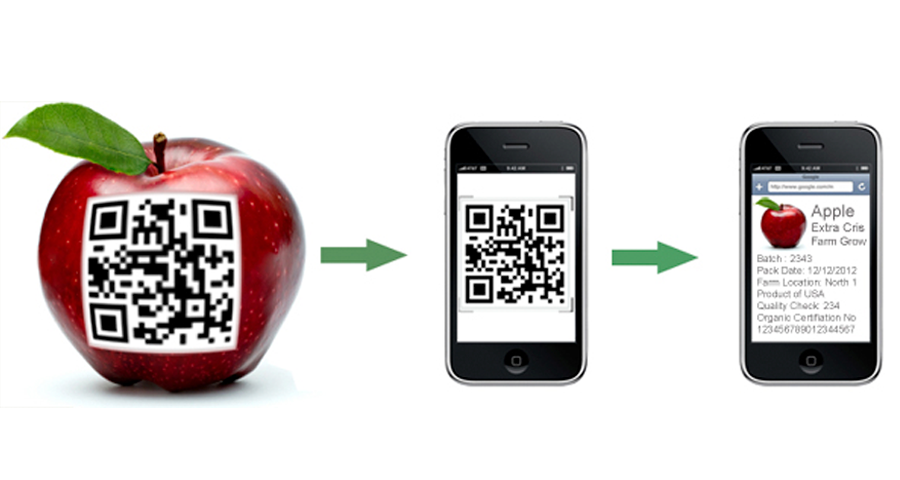Going Mobile for Internet of Things and Traceability

Throughout the food processing industry, traceability is on the minds of everyone from farm to fork. With thousands of possible steps on the way to the plate, there are plenty of opportunities for food to become contaminated.
Contamination can lead to product recalls, which can cost a company millions of dollars and damage a company’s reputation. When food recalls happen, it’s the responsibility of internal and external company investigators to identify and isolate the location of the problem along the food handling chain.
Identification is critical to a successful traceability program. Up until recently, batches were often identified with handwritten tags. Now, the industry is employing more sophisticated technology with the Industrial Internet of Things (IIoT), which includes sensors, radio frequency identification (RFID), and barcodes.
Mobile Computing Equips Inspection Personnel
Even with the farm/food processing industry enlisting this hardware, people are still very much part of the picture. An increasing number of operations are using industrial-grade mobile computing to input data and respond to ground-level situations.
These devices are a crucial component of the industry’s goal of going paperless to simplify operations, increase the likelihood of in-depth data collection, and ensure product quality. Food inspectors may have desks, but they are rarely at them. Instead, they are roaming the plant floor, the rows in the field, and the stockyards.
By using mobile computing devices rather than clipboards, the workers on the farm and in the plant are feeding data into the system, likely a cloud-based repository. Workers have real-time visibility into the food handling system with the ability to rapidly respond to food traceability issues. This arrangement enables the operation to augment the benefits of the IIoT strategy.
Many Still Use Paper
However, many operations are not yet ready to implement IIoT technology. In a recent InfinityQS study of 260 sites, including some of the largest processors, 75 percent of respondents admitted they are still manually collecting data, with an astonishing 45 percent relying on good old pencils, paper, and clipboards.
In these facilities, once the quality check is complete, the data can be easily lost. A recall or a check on compliance will kick off a flurry of excavation for the right piece of paper. Furthermore, paper files are often inaccessible on the plant floor when they are needed, so precious time is wasted searching for data when a quick response is required.
There are two reasons for the lack of initiative in bringing on this technology. In many companies, smartphones and computer tablets were discouraged and seen as distractions. However, a tech-savvy young workforce has exerted steady pressure to bring these devices onto the job.
Secondly, revamping an entire food production process with IIoT based monitoring can be overwhelming and seemingly cost-prohibitive. Gradually management in food production facilities recognize the cost benefit of this technology, especially compared with the tsunami of expenses a recall can bring. While the industry is developing the full IIoT farm
-to-fork system, mobile computing tablets can be part of the transition of building the farm/factory data profile.
Field and Factory Computer Tablets
Once management fully embraces the benefits of using mobile computing and makes the decision to purchase technology, it will be a bit more involved than just running out to the nearest big-box electronics store. The purchaser will need to consider the specific needs unique to the food handling environment.
No matter how modern the plant is, there’s no denying that it’s a rough environment for equipment, especially electronics. Farms and feedlots are indeed no easier in these environments, especially with the addition of the outdoor elements.
Here are some characteristics that a mobile computing tablet should offer to be effective and withstand the conditions in a farming or food-processing environment.
Ability to handle any environment. Even though the data will be stored safely in the cloud, it is being entered on the plant floor or the farm. Expect these units to be dropped from time to time. Look for MIL-STD-810 shock and drop resistance that can withstand typical 3-foot drops.
Component-level rugged design. Many industrial rugged tablets utilize onboard SSDs (solid-state drives) that help reduce a component’s footprint, resulting in a thinner and lighter mobile computer. Solid-state technology brings additional stability to the hard drive, especially when jostled. Electrical and mechanical components are designed to withstand industrial working conditions.
Designed to run with a variety of operating systems. Successful management involves getting the most useful life possible from your devices, and they need the ability to handle a range of operating systems. These systems are designed to work with an embedded roadmap, which has a longer life than consumer OS platforms and includes Windows Embedded (IoT), Windows Professional, and Linux, along with optional Android platforms.
Touchscreen design. The two must-have features for a tablet in an IIoT environment are readability and responsiveness. Information must be easily viewable from the screen at a quick glance as miscomprehension can lead to severe consequences. Rugged tablet PCs have various settings, automatic light sensors (ALS), and screen film options that account for low-light, sunlight, glare, and wide viewing angles. High-tech screens on rugged tablets are responsive to touch, even when the user is wearing gloves.
Protection against environmental hazards. Tablets will be used in dirty, dusty working conditions and areas with temperature extremes, especially for low-temperature operations. Throughout production facilities, operations frequently wash down equipment, so exposure to water is possible. Most industrial grade tablets are rated IP65, which keeps all dust and water out of the internal circuitry. Some tablets have unique wide temperature range options allowing processors to maintain optimal operating temperatures regardless of outdoor conditions.
Swiss army design. The goal for a computer tablet to be a truly mobile tool is to give a technician everything needed in the palm of his or her hand. To interface with the IIoT, rugged industrial tablets can have a variety of inputs. These can include having an RFID reader, a barcode scanner, Bluetooth, light sensors, temperature sensors, and an accelerometer. A built-in camera is ideal for transmitting still images and video to other collaborators in the system.
Going Where the Data Are
The power of the IIoT comes from its combination of connectedness, intelligence, and speed. Industrial computing tablets add the factor of mobility in their ability to acquire data and to act on them. It is about connecting devices throughout the supply chain and production processes to collect and interconnect operational data, which can be organized and quickly analyzed. This connectivity enables a multitude of powerful capabilities—including real-time process optimization, to an extent previously not possible.
Collecting, analyzing, and displaying production data from across a plant, product line, or enterprise in real-time enables IIoT systems to identify and rectify instances of non-compliance with standard operating procedures. Your mobile computing tablet representative can help you sort through the variety of designs to determine which is the best fit for your operation.
Hovanetz, a product manager at Teguar Computers, has 16 years of experience in the industrial computer hardware industry spent in engineering, sales, and product management. Reach him at chovanetz@teguaeer.com.
Source: https://www.foodqualityandsafety.com


